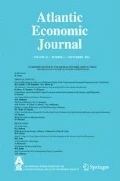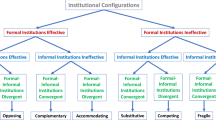Abstract
This paper studies the stabilization and welfare properties of various monetary policy regimes in a tractable framework suitable for the analysis of monetary policy in a small open economy environment with imperfect pass-through and inflation indexation. Using welfare criteria to evaluate the best monetary policy, results show that price-level targeting performs well and provides an alternative method for conducting successful monetary policy in the case of a small-open economy. Benefits of price-level targeting rules noted in the literature for closed economies also translate to the small open economy setting once allowing for the combination of inflation inertia and exchange rate imperfect pass-through. As the exchange rate is an important element of the transmission of monetary policy, movements in these variable and other foreign variables often account for a significant part of the variation in the consumer price index via their direct effect on the price of imported goods. Imperfect exchange rate pass-through favors the choice of price-level targeting over consumer price index inflation targeting.




Similar content being viewed by others
Notes
Campa and Goldberg (2005) rejected the hypothesis of complete pass-through in 22 of 25 countries during the 1975–99 sample period.
In their analysis of price-level versus inflation targeting, Batini and Yates (2003) demonstrated that output and inflation volatility may be dramatically worse under a price-level objective than under an inflation objective if expectations are formed in a backward-looking manner.
See Rabanal and Rubio-Ramírez (2005), for a general discussion about price indexation.
Erceg et al. (2000) used indexation to the steady-state inflation rate, allowing them to compute a linearized equation for inflation combining expected future inflation and lagged inflation. Their equation differs from the forward-looking inflation process obtained under the standard Calvo model.
The forward-looking pricing decision is related to the fact that firms that adjust their price in any period do so for a random number of periods. The price is then set as a markup over the average of expected future marginal costs.
Setting \( {\gamma}_p^{\ast } \) so that it is equal to the domestic price-indexation coefficient (or \( {\gamma}_p^{\ast}\ne 0 \)) does not significantly change the policy-evaluation results.
In our model, three definitions of output have to be handled: a measure of output, natural output (which can be derived in an economy with no imperfection or nominal rigidity) and finally the output gap, which is the difference between the output and the natural output.
Leith and Malley (2007) estimated an open-economy NKPC for the G7 countries, using a model with backward-looking behavior. They found that this parameter ranged from 0.54 in some countries to up to as high as 0.87 in others.
In the original Taylor rule, the weights on the output gap and inflation were set to the standard weight of 0.5, which is common in the literature.
The application of the quadratic approximation of the objective function is complex and cannot be simply derived in an open-economy model with sticky prices. A popular measure thus uses inflation and output gap volatility, in addition to the utility function.
References
Ambler, S. (2014). Price-level targeting: a post mortem?. C.D. Howe Institute, Commentary No. 400. Available online at: https://papers.ssrn.com/sol3/papers.cfm?abstract_id=2395493
Bailliu, J., Meh, C., & Zhang, Y. (2015). Macroprudential rules and monetary policy when financial frictions matter. Economic Modelling, 50, 148–161.
Batini, N., & Yates, A. (2003). Hybrid inflation and price level targeting. Journal of Money, Credit and Banking, 35, 283–300.
Calvo, G. (1983). Staggered prices in a utility maximizing framework. Journal of Monetary Economics, 12, 383–398.
Campa, J., & Goldberg, L. S. (2005). Exchange rate pass through into import prices. Review of Economics and Statistics, 87(4), 679–690.
Christiano, L. J., Eichenbaum, M., & Evans, C. L. (2005). Nominal rigidities and the dynamic effects of a shock to monetary policy. Journal of Political Economy, 113(1), 1–45.
Clarida, R., Galí, J., & Gertler, M. (2000). Monetary policy rules and macroeconomic stability: Evidence and some theory. Quarterly Journal of Economics, 115(1), 147–180.
Clarida, R., Galí, J., & Gertler, M. (2002). A simple framework for international monetary policy analysis. Journal of Monetary Economics, 49(5), 879–904.
Devereux, M., Lane, P., & Xu, J. (2006). Exchange rates and monetary policyin emerging market economies. The Economic Journal, 116(511), 478–506.
Douch, M., & Essaddam, N. (2010). Monetary policy conduct: A hybrid framework. Journal of Economics and International Finance, 2(7), 119–137.
Erceg, C. J., Henderson, D. W., & Levine, A. T. (2000). Optimal monetary policy with staggered wage and price contracts. Journal of Monetary Economics, 46, 281–313.
Flamini, A. (2005). Inflation targeting and exchange rate pass-through. Graduate Institute of International Studies, HEI working paper no: 04/2004. Available at: https://pdfs.semanticscholar.org/fe5f/55285c595ac890fe9126ab05d85c972086be.pdf
Fuhrer, J. C., & Moore, G. R. (1995). Inflation persistence. Quarterly Journal of Economics, 111(1), 127–159.
Galí, J., & Monacelli, T. (2005). Monetary policy and exchange rate volatility in a small open economy. The Review of Economic Studies, 72(3), 1–28.
Goodfriend, M. S., & King, R. G. (2001). “The case for price stability,” in ‘why price stability?’. In Proceedings of the ECB first ECB central banking conference (pp. 53–94). Frankfurt am Main: Frankfurt European Central Bank. Also available as NBER working paper, no 8423. Available at: https://www.nber.org/papers/w8423.
Hatcher, M., & Minford, P. (2016). Stabilisation policy, rational expectations and price-level versus inflation targeting: A survey. Journal of Economic Surveys, 30(2), 327–355.
Justiniano, A., & Preston, B. (2010). Monetary policy and uncertainty in an empirical small open-economy model. Journal of Applied Econometrics, 25(1), 93–128.
Kollmann, R. (2002). Monetary policy rules in the open economy: Effects on welfare and business cycles. Journal of Monetary Economics, 49(5), 989–1015.
Leith, C., & Malley, J. (2007). Estimated open economy new Keynisian Phillips curves for the G7. Open Economies Review, 18(4), 405–426.
Mishkin, F. S., & Schmidt-Hebbel, K. (2002). One decade of inflation targeting in the world: What do we know and what do we need to know? In N. Loayza & R. Soto (Eds.), Inflation targeting: Design, performance, challenges (pp. 171–219). Santiago: Central Bank of Chile.
Rabanal, P., & Rubio-Ramírez, J. (2005). Comparing new Keynesian models of the business cycle: A Bayesian approach. Journal of Monetary Economics, vol., 52(6), 1151–1166.
Røisland, Ø. (2006). Inflation inertia and the optimal hybrid inflation/price-level target. Journal of Money, Credit and Banking, 38(8), 2247–2251.
Rubio, M., & Carrasco-Gallego, J. A. (2014). Macroprudential and monetary policies: Implications for financial stability and welfare. Journal of Banking and Finance, 49(C), 326–336.
Sahuc, J. G. (2004). Partial indexation and inflation dynamics: What do the data say. Applied Economics Letters, 11(13), 827–832.
Smets, F., & Wouters, R. (2003). An estimated stochastic dynamic general equilibrium model of the euro area. Journal of the European Economic Association, 1, 1123–1175.
Taylor, J. B. (1993). Macroeconomic policy in a world economy: From econometric design to practical operation. New York: W W Norton.
Taylor, J. B. (1999). A historical analysis of monetary policy rules. In J. B. Taylor (Ed.), Monetary policy rules. Chicago: University of Chicago Press.
Woodford, M. (2003). Interest and prices: Foundations of a theory of monetary policy. Princeton University Press: Princeton.
Yun, T. (1996). Monetary policy, nominal price rigidity, and business cycles. Journal of Monetary Economics, 37, 345–370.
Author information
Authors and Affiliations
Corresponding author
Additional information
Publisher’s Note
Springer Nature remains neutral with regard to jurisdictional claims in published maps and institutional affiliations.
Electronic supplementary material
ESM 1
(DOCX 945 kb)
Rights and permissions
About this article
Cite this article
Douch, M. Monetary Policy in a Small Open Economy with Imperfect Pass-Through. Atl Econ J 47, 445–461 (2019). https://doi.org/10.1007/s11293-019-09646-1
Published:
Issue Date:
DOI: https://doi.org/10.1007/s11293-019-09646-1
Keywords
- Small-open economy
- Monetary policy
- Inflation targeting
- Price level targeting
- Exchange rate imperfect pass-through




